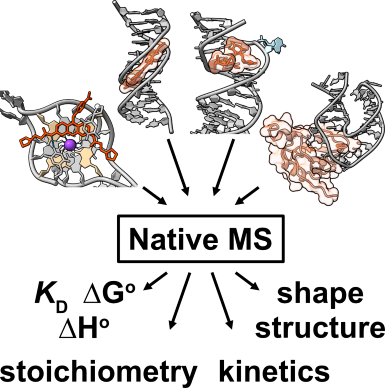Mass spectrometry for biophysics
New concepts in mass spectrometry measurements and interpretation
Mass spectrometry of oligonucleotides and nucleic acids
Mass Spectrometry for Biophysics
Biophysical assays to test target structure and ligand binding stoichiometry, affinity, specificity and binding modes are part of the drug development pipeline. Mass spectrometry offers unique advantages as a biophysical method due to its ability to distinguish each stoichiometry present in a mixture. In addition, advanced mass spectrometry approaches (reactive probing, fragmentation techniques, ion mobility spectrometry, ion spectroscopy) provide more detailed information on the complexes.
Previous work: This has been a key topic of the Gabelica group for over 20 years, summarized in a comprehensive review of fundamentals of mass spectrometry and all its particularities when studying non-covalent nucleic acid structures. We also reviewed what has been learned thanks to mass spectrometry on nucleic acid structures, self-assemblies (e.g., duplexes or G-quadruplexes), and their complexes with ligands [1]. New projects are outlined below.
